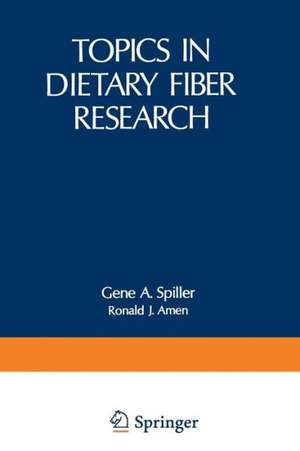Topics in Dietary Fiber Research
Editat de Gene Spilleren Limba Engleză Paperback – 19 mar 2012
Preț: 364.89 lei
Preț vechi: 384.09 lei
-5% Nou
Puncte Express: 547
Preț estimativ în valută:
69.82€ • 73.08$ • 58.11£
69.82€ • 73.08$ • 58.11£
Carte tipărită la comandă
Livrare economică 31 martie-14 aprilie
Preluare comenzi: 021 569.72.76
Specificații
ISBN-13: 9781468424836
ISBN-10: 1468424831
Pagini: 236
Ilustrații: X, 224 p.
Dimensiuni: 152 x 229 x 12 mm
Greutate: 0.32 kg
Ediția:Softcover reprint of the original 1st ed. 1978
Editura: Springer Us
Colecția Springer
Locul publicării:New York, NY, United States
ISBN-10: 1468424831
Pagini: 236
Ilustrații: X, 224 p.
Dimensiuni: 152 x 229 x 12 mm
Greutate: 0.32 kg
Ediția:Softcover reprint of the original 1st ed. 1978
Editura: Springer Us
Colecția Springer
Locul publicării:New York, NY, United States
Public țintă
ResearchCuprins
1 — The Detergent System of Fiber Analysis.- I. Introduction.- II. Systems of Fiber Analysis.- III. The Detergent Systems.- IV. Nutritional Implications of the Detergent Systems.- V. In-Vitro Cell-Wall Digestion.- VI. Procedures in the Detergent System of Fiber Analysis.- VII. Conclusions.- References.- 2 — Wheat Bran: Composition and Digestibility..- I. Introduction.- II. Morphology of Bran.- III. Composition of Bran.- IV. Bran Digestibility.- V. Fiber Versus Indigestible Residue.- VI. Conclusion.- References.- 3 — The Chemical Structure of Lignin and Quantitative and Qualitative Methods of Analysis in Foodstuffs.- I. Introduction.- II. Structure of the Plant Cell Wall.- III. The Chemistry of Lignin.- IV. Analytical Methods for Lignin.- V. Effect of Digestion on Lignin.- VI. Lignin Content of Human Foods.- VII. Summary.- References.- 4 — Pectin.- I. Chemistry and Nomenclature.- II. Pectic Enzymes.- III. Pectin Content of Plant Materials.- IV. Gel Formation.- V. Pectin Metabolism.- VI. Conclusion.- References.- 5 — Plant Fibers and Human Health.- I. Introduction.- II. Dietary Fiber in Vegetarian and Nonvegetarian Diets.- III. Dietary Fiber and Epidemiological Aspect of Disease.- IV. Conclusion.- References.- 6 — Fermentation as the Principal Cause of the Physiological Activity of Indigestible Food Residue.- I. Introduction.- II. The Indigestible Residue of Vegetable Foods and its Fate in the Body.- III. Variable Rate of Starch Digestion.- IV. Fermentation as the Cause of Intestinal Gas Formation.- V. Fermentation as the Cause of Accelerated Transit in the Large Bowel.- VI. The Effects Intestinal Bacteria and Food Residue Exert on Excretion of Sterols.- VII. Conclusions.- References.- 7 — Practical Dietary Research Design and Applications for SouthwesternAmerican Indians.- I. Introduction.- II. Fiber Selection.- III. Dietary Calculation.- IV. Dietary Design.- V. Differences in Populations.- VI. Conclusion.- References.- 8 — Paleodietetics: A Review of the Role of Dietary Fiber in Preagricultural Human Diets.- I. Introduction.- II. Coprolites from Pleistocene Contexts.- III. Desiccated Coprolites from Postpleistocene Contexts.- IV. The Role of Nonphytic Biopolymers in Preagricultural Human Diets.- V. Possible Morphological Adaptations to the Fiber Content of the Diet.- VI. Summary.- References.- Appendix — Dietary Fiber Content of Foods.- References.- Contributors.








